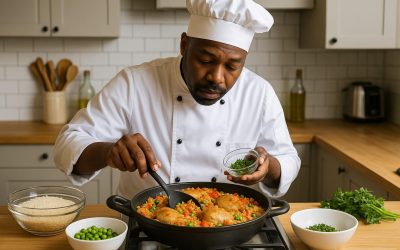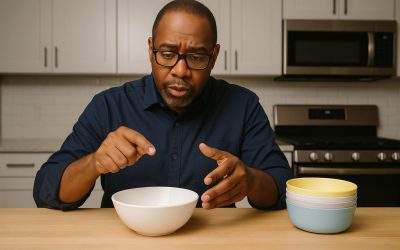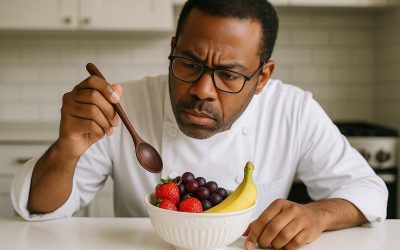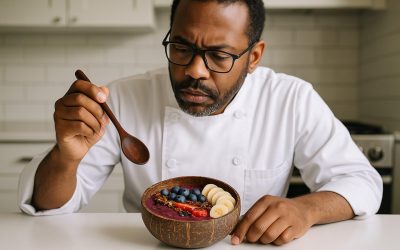As an Amazon Associate I earn from qualifying purchases.
In the quest for innovative and effortless breakfast ideas, the rice cooker pancake emerges as a delightful surprise, challenging traditional pancake-making methods with its simplicity and unique charm. This culinary hack turns a basic kitchen appliance, often reserved for cooking grains, into a versatile tool for crafting a fluffy, cake-like pancake with minimal effort. The beauty of this method lies in its ease and the surprising joy of flipping open the rice cooker lid to reveal a perfectly cooked, giant pancake that’s ready to be sliced and served.
Gone are the days of standing over a hot stove, meticulously flipping individual pancakes, and battling uneven cooking. The rice cooker pancake offers a set-it-and-forget-it approach, allowing for a more relaxed morning routine. Whether you’re a busy parent looking for a quick breakfast solution, a college student with limited kitchen appliances, or simply a pancake aficionado eager to try a new technique, this method is sure to impress.
This article will guide you through the steps to achieve the best rice cooker pancake, from crafting the ideal batter consistency to expert tips on customization and storage. We’ll explore why this innovative approach not only simplifies the cooking process but also enhances the texture and flavor of the pancake, making it a standout dish. Whether you’re new to the concept or looking to perfect your technique, you’re in for a treat. Prepare to elevate your breakfast game with the rice cooker pancake, a delightful twist on a classic favorite that promises to make mornings more exciting.
How to Make the Best Rice Cooker Pancake
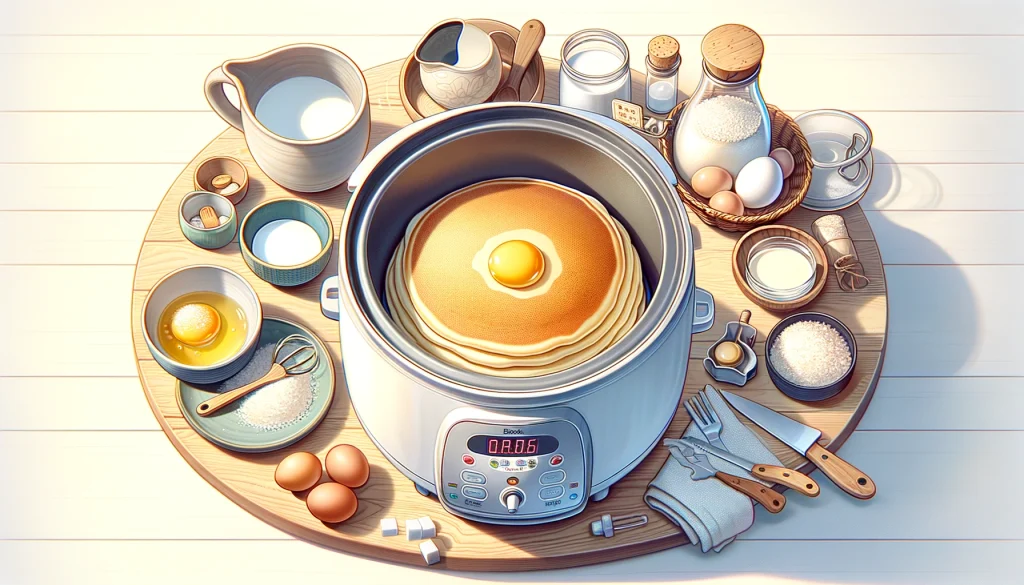
Making a pancake in a rice cooker is a fun and easy way to prepare a fluffy and giant pancake that’s perfect for sharing. This method is great for those who want to enjoy pancakes without the hassle of flipping them on a griddle. Here’s how to make the best rice cooker pancake:
Ingredients:
- 2 cups all-purpose flour
- 2 tablespoons sugar (adjust to taste)
- 2 teaspoons baking powder
- 1/2 teaspoon salt
- 2 eggs
- 1 1/2 cups milk
- 1/4 cup melted butter, plus a little extra for greasing
- 1 teaspoon vanilla extract (optional)
- Toppings of your choice: fresh fruits, chocolate chips, nuts, syrup, honey, or whipped cream
Instructions:
- Mix Dry Ingredients: In a large bowl, sift together the flour, sugar, baking powder, and salt.
- Combine Wet Ingredients: In another bowl, beat the eggs, then mix in the milk, melted butter, and vanilla extract if using.
- Combine Wet and Dry Ingredients: Pour the wet ingredients into the dry ingredients. Stir until just combined; it’s okay if the batter is a bit lumpy. Avoid overmixing to ensure your pancake stays fluffy.
- Prepare Your Rice Cooker: Grease the inside of your rice cooker pot with a little butter to prevent sticking. This also adds a nice flavor to the pancake.
- Pour the Batter: Pour the pancake batter into the greased rice cooker pot. Don’t fill the pot more than halfway to allow room for the pancake to rise.
- Cook the Pancake: Close the rice cooker lid and set it to the standard cooking setting, usually the same one you would use for white rice. Depending on your rice cooker, this could take about 45 minutes to 1 hour. Some rice cookers might switch to ‘warm’ mode a few times during cooking; if this happens, simply restart the cooking cycle until the pancake is fully cooked.
- Check Doneness: Insert a toothpick or a skewer into the center of the pancake. If it comes out clean, the pancake is ready. If not, cook it a bit longer.
- Serve: Once cooked, carefully remove the pancake from the rice cooker. You might need to invert the pot onto a large plate. Top with your favorite toppings like fresh fruits, syrup, or whipped cream.
Tips for the Best Rice Cooker Pancake:
- Choosing the Right Rice Cooker: This recipe works best with a standard electric rice cooker that has a simple cook/warm function. More complex rice cookers with fuzzy logic might have different results.
- Customize Your Pancake: Feel free to add mix-ins to your batter, like blueberries, chocolate chips, or sliced bananas, for extra flavor.
- Serving: This pancake is best served fresh, but it can also be stored in the refrigerator and reheated in a toaster or microwave.
- Safety First: Be cautious when flipping or removing the hot pancake from the rice cooker.
Enjoy your giant, fluffy pancake with minimal effort and maximum deliciousness. This rice cooker pancake method is not only a novelty but also a convenient way to enjoy pancakes without standing over the stove.
Expert Tips
Making pancakes in a rice cooker is a fun and easy way to prepare breakfast without much fuss. Here are some expert tips to ensure your rice cooker pancakes turn out perfectly every time:
- Choose the Right Batter Consistency: The batter should be slightly thicker than the typical pancake batter to prevent it from spreading too thinly and evenly in the rice cooker. However, it shouldn’t be too thick; aim for a pourable consistency that will settle nicely.
- Grease the Rice Cooker Pot: Before adding your batter, lightly grease the bottom and sides of the rice cooker pot with butter or a neutral oil. This helps in preventing the pancake from sticking and makes it easier to remove once cooked.
- Don’t Overfill: Fill the rice cooker pot only to about halfway or a maximum of two-thirds with batter. This allows the pancake to rise without spilling over. Rice cookers vary in size, so adjust the amount of batter accordingly.
- Use the Correct Setting: If your rice cooker has a cake setting, use that. If not, the regular rice cooking setting works fine. Some rice cookers may require you to start a new cooking cycle once the first one finishes to ensure the pancake is cooked through.
- Check for Doneness: Depending on the size and model of your rice cooker, cooking times can vary. A good rule of thumb is to check after about 45 minutes to an hour. Insert a toothpick into the center of the pancake; if it comes out clean, the pancake is done.
- Flipping (Optional): For an even browning on both sides, if your rice cooker’s design allows, carefully flip the pancake halfway through the cooking process. This might require some practice and a large plate to assist in the flip.
- Add-Ins and Toppings: Customize your pancake by adding fruits like blueberries, slices of banana, or chocolate chips into the batter before cooking. After cooking, you can top it with syrup, fresh fruits, whipped cream, or nut butter for extra flavor.
- Let it Rest: Once the pancake is done, let it sit for a few minutes before cutting into it. This allows it to firm up a bit and makes it easier to slice.
- Cleaning Up: To make cleaning easier, soak the rice cooker pot in warm, soapy water soon after you’ve removed the pancake. This will help prevent any residue from sticking.
- Experiment: Don’t be afraid to experiment with different batter recipes or mix-ins. Pancakes are versatile, and making them in a rice cooker can be a fun way to test out new combinations.
Remember, every rice cooker is different, so it might take a couple of attempts to perfect your technique. Enjoy the process and the delicious, fluffy pancakes that result!
Why This Recipe Is Just So Good…
The rice cooker pancake recipe is particularly delightful for several reasons that make it stand out from traditional pancake making methods:
- Simplicity and Convenience: Using a rice cooker simplifies the pancake-making process. There’s no need to stand over a stove, flip pancakes individually, or worry about uneven cooking. You just pour the batter in, start the cooker, and let it do its magic. This convenience is a significant plus for anyone looking for an easy breakfast option.
- Uniform Cooking: The rice cooker evenly distributes heat, ensuring that the pancake cooks uniformly. This method eliminates the common problem of pancakes being burnt on the outside and raw in the middle, which can happen on a stove.
- Texture: The even heat and steam within the rice cooker create a moist, fluffy pancake that’s hard to achieve with traditional frying methods. The enclosed cooking environment helps retain moisture, leading to a soft, cake-like texture that’s thoroughly enjoyable.
- Size and Shape: The pancake made in a rice cooker is uniquely thick and perfectly round, resembling a cake. This not only makes for an impressive presentation but also allows for easy slicing and serving. The thickness contributes to the pancake’s satisfying texture and mouthfeel.
- Customization: Just like traditional pancakes, the batter for rice cooker pancakes can be easily customized with various mix-ins and toppings. This adaptability allows for endless flavor combinations, catering to different tastes and making each pancake experience unique.
- Effortless Hosting: For those hosting breakfast or brunch, a rice cooker pancake is an efficient way to serve a crowd without spending hours in the kitchen. It’s a novel approach that’s sure to impress guests with both the presentation and the taste.
- Less Mess: Traditional pancake making can be messy, with batter drips on the counter and multiple pans to clean. The rice cooker method contains the mess to one pot, simplifying both preparation and cleanup.
- Experimentation and Fun: The process of making a pancake in a rice cooker can be a fun experiment, especially for families with children. It’s a different and exciting way to engage with cooking, turning breakfast into an adventure.
In essence, the rice cooker pancake combines the joy of cooking with practical benefits, resulting in a delicious, fluffy, and impressive breakfast option that appeals to cooks of all skill levels. Its simplicity, combined with the potential for customization and the delightful texture of the finished product, makes it a beloved recipe for many.
Storage Instructions
Storing a rice cooker pancake properly ensures that it remains fresh and delicious for as long as possible. Here are some storage instructions to follow:
Short-Term Storage (Up to 2 Days)
- Cool Down: Allow the pancake to cool completely to room temperature after cooking. Storing it while still warm can lead to condensation inside the container, making the pancake soggy.
- Wrap Tightly: Once cooled, wrap the pancake tightly in plastic wrap or aluminum foil. This helps to keep it moist and prevents it from drying out.
- Refrigerate: Place the wrapped pancake in the refrigerator. It should stay fresh for up to 2 days.
Long-Term Storage (Up to 3 Months)
- Cool Down: As with short-term storage, let the pancake cool completely to avoid condensation.
- Slice (Optional): For more convenient serving later, you can slice the pancake before freezing. This way, you can thaw only as much as you need at a time.
- Wrap Individually: If you’ve sliced the pancake, wrap each piece individually in plastic wrap. For an entire pancake, wrap it thoroughly in a layer of plastic wrap followed by a layer of aluminum foil to protect it from freezer burn.
- Freeze: Place the wrapped pancake or slices in a freezer-safe bag or container. Remove as much air as possible from the bag to prevent freezer burn. Label the bag or container with the date.
- Thaw and Reheat: When ready to eat, thaw the pancake in the refrigerator overnight. Reheat it in a microwave, oven, or toaster oven until warm. If reheating from frozen, adjust the time accordingly.
Tips for Best Quality
- Avoid Frequent Temperature Changes: Repeatedly freezing and thawing the pancake can affect its texture and taste. Try to avoid this by freezing in portions that you will use in one go.
- Consume Within 3 Months: While frozen food can remain safe to eat indefinitely, for the best quality, consume your rice cooker pancake within three months of freezing.
- Reheating: For the best texture, reheat the pancake covered in the microwave with a damp paper towel on top or wrapped in aluminum foil in the oven. This helps to keep it moist.
Following these storage instructions will help ensure that your rice cooker pancake remains as delicious as when it was first made, whether you’re enjoying it the next day or several weeks later.
Frequently Asked Questions (FAQ)
Creating the best rice cooker pancake involves understanding some nuances of the process. Here are some expert questions and answers that can help perfect your rice cooker pancake-making skills:
Q: What type of batter works best for rice cooker pancakes?
A: A thicker batter than the one used for traditional pancakes tends to work best for rice cooker pancakes. This consistency helps maintain the pancake’s shape and ensures it cooks evenly without spreading too thin. However, it should still be pourable. You can start with your favorite pancake mix or recipe and adjust the liquid content as needed to achieve a slightly thicker consistency.
Q: How can I prevent the bottom of the pancake from getting too brown or burnt?
A: To prevent excessive browning or burning on the bottom, you can lightly grease the rice cooker pot with butter or a neutral oil before adding your batter. Additionally, using the “keep warm” setting for a short period after the cooking cycle can help distribute the heat more evenly without adding too much direct heat to the bottom.
Q: Can I add fruits or other mix-ins to my rice cooker pancake?
A: Yes, you can add fruits, nuts, chocolate chips, or other mix-ins to your pancake batter. To ensure even distribution and prevent sinking, lightly coat your add-ins with flour before folding them into the batter. Add them to the batter just before cooking to prevent them from sinking to the bottom.
Q: How do I know when the pancake is fully cooked?
A: Cooking times can vary depending on the size and model of your rice cooker. A general guideline is to check the pancake after about 45 minutes to an hour of cooking. Insert a toothpick or skewer into the center of the pancake; if it comes out clean, the pancake is done. If your rice cooker has a cake setting, using that can also help ensure thorough cooking.
Q: Is it possible to make a vegan or gluten-free rice cooker pancake?
A: Absolutely! You can easily adapt the recipe to be vegan or gluten-free by using suitable substitutes. For a vegan pancake, use plant-based milk and a vegan egg substitute. For a gluten-free version, use a gluten-free flour blend in place of regular flour. Just ensure the batter has the right consistency for optimal results.
Q: How can I flip the pancake to brown both sides?
A: Flipping a large pancake in a rice cooker can be challenging due to its size and the shape of the pot. If you’re keen on browning both sides, you can try carefully removing the pancake once it’s mostly cooked, then using a plate to invert it back into the rice cooker to cook the other side for a few minutes. However, this step is optional, and many find the pancake delicious without flipping.
Q: What’s the best way to serve a rice cooker pancake?
A: A rice cooker pancake can be served similarly to traditional pancakes. Slice it like a cake and serve with your favorite toppings such as maple syrup, fresh fruits, whipped cream, or a dusting of powdered sugar. For a fun twist, you can also layer slices with fruit or cream between them to make a pancake “cake.”
Q: How can I store leftovers, and can they be reheated?
A: Leftover rice cooker pancakes can be stored in the refrigerator for up to 2 days or frozen for up to 3 months. Wrap them tightly in plastic wrap or place them in an airtight container. To reheat, microwave them on a low setting with a damp paper towel on top to keep them moist, or warm them in an oven or toaster oven until heated through.
Mastering the art of making the perfect rice cooker pancake may take a bit of practice, but these tips and tricks can help you achieve great results every time. Experiment with different ingredients and toppings to find your favorite combination.
Conclusion
As we conclude our exploration of making the best rice cooker pancake, it’s clear that this innovative method combines ease, convenience, and culinary creativity, transforming a simple breakfast staple into a delightful and impressive dish. The rice cooker pancake not only challenges traditional cooking methods but also opens up a world of possibilities for those looking to diversify their breakfast repertoire without adding complexity to their morning routine.
Through the expert tips and detailed guidance provided, we’ve learned the importance of batter consistency, the versatility of mix-ins and toppings, and the practicality of using a rice cooker for more than just cooking rice. This method proves that with a little creativity, even the most humble kitchen appliances can be repurposed to create something unexpectedly wonderful.
Whether you’re a seasoned chef or a cooking novice, the rice cooker pancake offers a foolproof way to enjoy a delicious, cake-like pancake that requires minimal effort and cleanup. It’s a reminder that sometimes, the best culinary creations come from thinking outside the box—or in this case, outside the traditional pancake skillet.
So, the next time you’re pondering over what to make for breakfast, consider the rice cooker pancake. It’s not just about the novelty of using a rice cooker for pancakes; it’s about embracing simplicity and enjoying the process of making and sharing a meal that brings a smile to everyone’s face. Here’s to more enjoyable and stress-free mornings, one giant pancake at a time.


